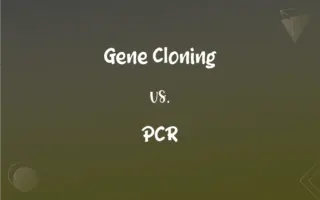Microelements vs. Macroelements: What's the Difference?
Edited by Janet White || By Harlon Moss || Updated on October 19, 2023
Microelements are trace minerals required in minute amounts; macroelements are primary minerals needed in larger quantities.

Key Differences
Microelements and macroelements play crucial roles in the functioning of living organisms. While microelements, often referred to as trace elements, are needed in minute amounts, macroelements are required by the body in larger quantities.
Essential for various biological functions, microelements include elements like zinc, copper, and selenium. In contrast, macroelements encompass elements like carbon, hydrogen, and oxygen, which form the foundational blocks of organic molecules.
A deficiency or excess of microelements can lead to health problems, signaling the importance of their fine-tuned balance. Macroelements, on the other hand, are vital for basic physiological functions and form the structure of cells and tissues.
The primary sources of microelements are often dietary supplements or specific foods rich in these minerals. Macroelements, however, are generally derived from a broader range of foods since they comprise the main components of our diet.
Both microelements and macroelements are indispensable to life. While microelements act mostly as catalysts in enzyme functions, macroelements serve as the main building blocks of cells and are pivotal in energy production.
ADVERTISEMENT
Comparison Chart
Quantity Needed
Required in minute amounts
Needed in larger quantities
Examples
Zinc, copper, selenium
Carbon, hydrogen, oxygen
Physiological Role
Catalysts in enzyme functions
Building blocks of cells, energy production
Dietary Sources
Specific foods, supplements
Broad range of foods
Consequence of Imbalance
Deficiency or excess can cause health problems
Essential for basic physiological functions
ADVERTISEMENT
Microelements and Macroelements Definitions
Microelements
Microelements often act as enzyme co-factors.
Certain microelements are vital for enzymatic reactions.
Macroelements
Macroelements are primary minerals.
Macroelements like oxygen form the basis of life.
Microelements
Microelements are essential for specific biological roles.
Zinc, a microelement, aids in DNA synthesis and wound healing.
Macroelements
Macroelements function in larger amounts.
Our bodies require substantial quantities of macroelements daily.
Microelements
Microelements are trace minerals.
The body requires microelements like selenium for antioxidant functions.
Macroelements
Macroelements support energy metabolism.
Carbohydrates, made of macroelements, are primary energy sources.
Microelements
Microelements function in tiny amounts.
Even in small quantities, microelements play crucial roles.
Macroelements
Macroelements maintain structural and physiological functions.
Calcium, a macroelement, is crucial for bone health and muscle function.
Microelements
Microelements help maintain a physiological balance.
Deficiencies in microelements can disrupt homeostasis.
Macroelements
Macroelements are core components of cells.
Phosphorus, a macroelement, is a key part of DNA and ATP.
Microelements
A trace element.
Macroelements
Plural of macroelement
Microelements
Plural of microelement
FAQs
Can you give examples of microelements?
Examples of microelements include zinc, copper, and selenium.
What are microelements?
Microelements, or trace elements, are minerals required in minute amounts by the body.
Can an imbalance in microelements affect health?
Yes, both a deficiency or excess of microelements can lead to health problems.
What foods are rich in microelements?
Foods like oysters (zinc), nuts (selenium), and shellfish (copper) are rich in specific microelements.
How can I ensure I'm getting enough macroelements in my diet?
Consuming a balanced diet with diverse foods usually provides the necessary macroelements.
Are all microelements metals?
No, while many are metals, some like iodine and selenium are non-metals.
Can one overdose on microelements?
Yes, excessive intake of certain microelements can be toxic and harmful.
Do all living organisms need macroelements?
Yes, all living organisms require macroelements for survival and physiological functions.
What happens if the body lacks macroelements?
A deficiency can disrupt vital physiological processes and overall health.
Why are microelements important?
Microelements play specific roles, often acting as enzyme co-factors or aiding in physiological processes.
How do microelements interact with the body?
Microelements often act as catalysts in various enzyme functions.
Why are macroelements essential?
Macroelements are fundamental to life, being main components of cells and critical for energy production.
Which elements are considered macroelements?
Carbon, hydrogen, oxygen, and nitrogen are key examples of macroelements.
How do macroelements support life?
Macroelements form the foundational blocks of organic molecules and are vital for energy and cell structure.
Are macroelements present in every meal?
Generally, yes. Macroelements like carbon and hydrogen are present in most foods we consume.
Are macroelements only about quantity?
While quantity is a distinguishing feature, macroelements also have specific physiological roles.
How are microelements absorbed in the body?
They are absorbed from food through the digestive tract, often facilitated by transport molecules.
Can I take microelement supplements?
Yes, but it's advisable to consult a healthcare professional before starting any supplementation.
How are macroelements different from microelements?
Macroelements are needed in larger quantities, while microelements are required in tiny amounts.
How do macroelements and microelements interact?
They work synergistically in the body to support various physiological processes and functions.
About Author
Written by
Harlon MossHarlon is a seasoned quality moderator and accomplished content writer for Difference Wiki. An alumnus of the prestigious University of California, he earned his degree in Computer Science. Leveraging his academic background, Harlon brings a meticulous and informed perspective to his work, ensuring content accuracy and excellence.
Edited by
Janet WhiteJanet White has been an esteemed writer and blogger for Difference Wiki. Holding a Master's degree in Science and Medical Journalism from the prestigious Boston University, she has consistently demonstrated her expertise and passion for her field. When she's not immersed in her work, Janet relishes her time exercising, delving into a good book, and cherishing moments with friends and family.































































